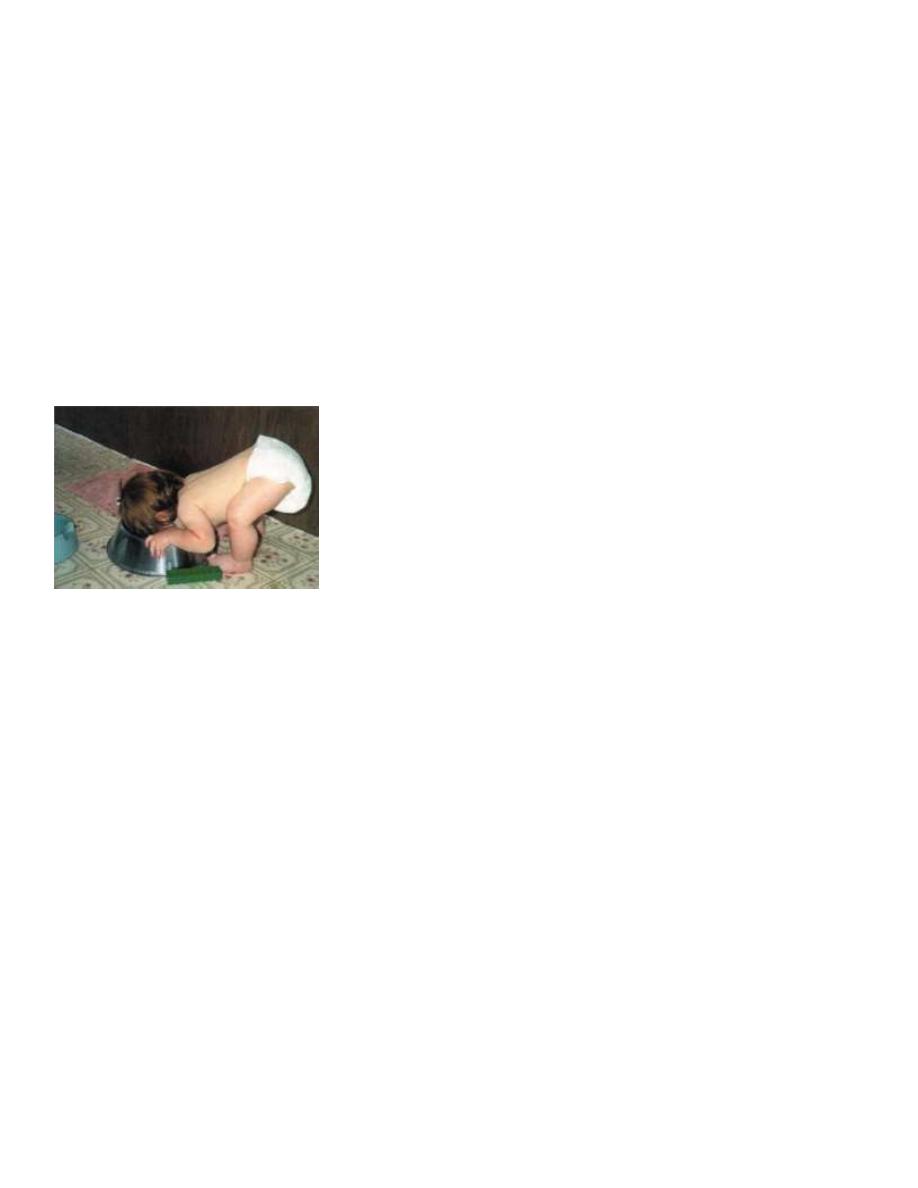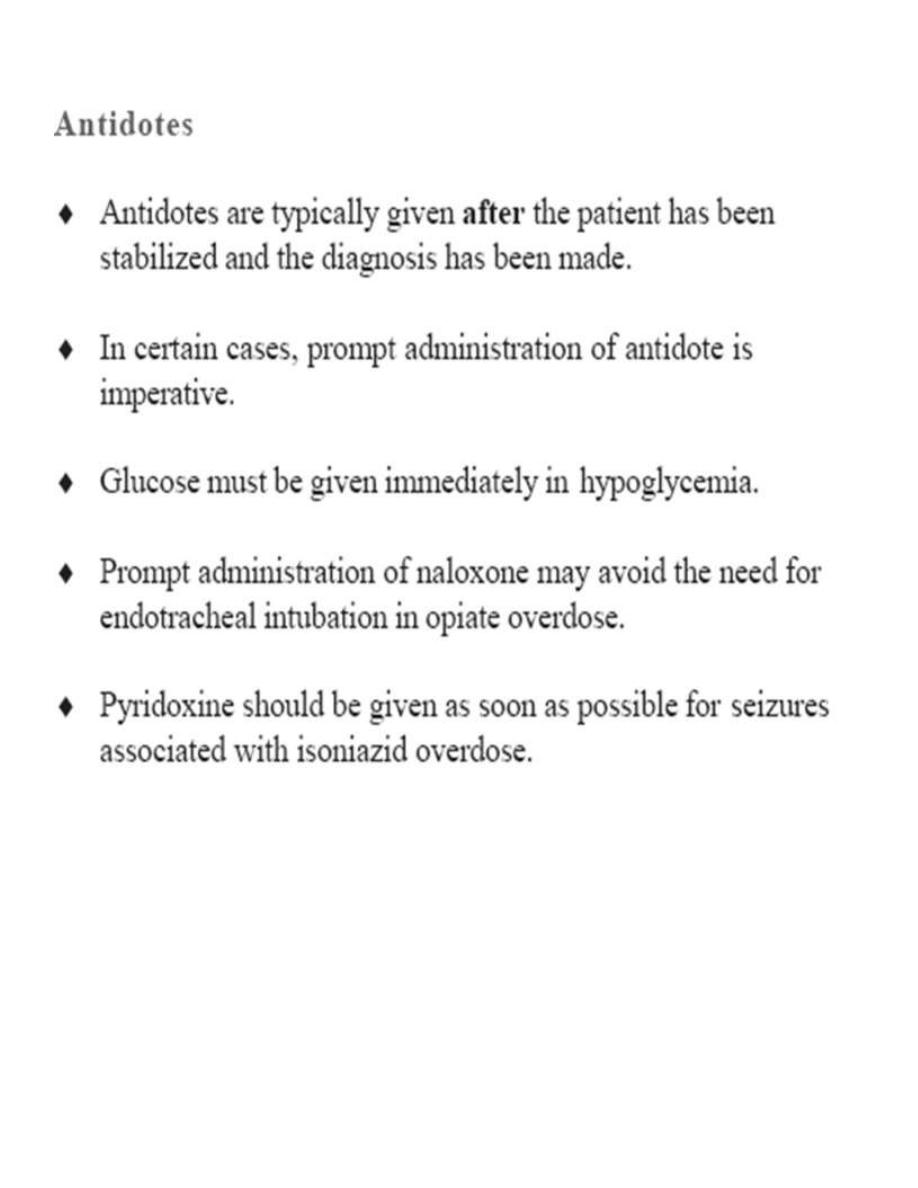
paediatrics
dr.zyad
1
POISONING
Poisons are substances that if inhaled, absorbed or injected, harm the structures or functions
of the body.Circumstances of Exposure can be intentional, accidental, environmental,
medicinal or recreational.Routes of exposure can be ingestion, injection, inhalation or
cutaneous exposure.
All substances are poisons...the right dose separates poison from a remedy
Special Pediatric Issues
ALL THINGS TEND TO END UP IN THE MOUTHS OF YOUNG CHILDREN!!
Which is Candy?
Some types of poisons may act immediately on the body, others may act more slowly. Some
poisons, such as cyanide, are so toxic they only require a very small amount to be
harmful,while others, such as garden sprays, are cumulative and require exposure over a long
period to achieve the same level of toxicity. Some may be carcinogenic, and cause fatal
cancers, some years after exposure.
More than 1.5 million calls to poison control centers each year.More than ¾ involve children
under 5 yrs.Most poisonings are accidental.Substantial number are suicide attempts. 56% of
pediatric exposures are from products around the house including medicines, cleaning agents,
pesticides, plants and cosmetics.
SOURCES OF POISONING:
1. Acids & alkalis: Household cleaners frequently contain caustic acids and alkalis
2. Petroleum products: gasoline, kerosene, benzene, mineral spirits, furniture polishes, paint
thinners, and other solvents

paediatrics
dr.zyad
2
3. Industrial poisons: Poisonings from lead, mercury, and other heavy metals
4. Medications as poisons: Almost any medication taken in a large quantity can be toxic;
Aspirin remains one of the leading causes of accidental poisoning in young children. Iron pills
and multivitamins containing iron are a major source of childhood poisoning.
5. Poisonous plants: May be the entire plant or parts that are poisonous Plants are second only
to medicines as the cause of serious poisoning in children < 5
6. Pesticide poisoning: Accidental exposure or overexposure to pesticides can have serious
implications, Most pesticides can be used with relatively little risk ( following label directions)
but used in a wrong manner, some are extremely toxic.
SYMPTOMS OF POISONING:
Different poisons affect the body in different ways and can take effect quickly or over time.
The risk depends on a variety of factors including:
1-the amount swallowed or injected
2-the length of exposure (through ingestion, inhalation or skin contact)
3-the time since exposure to the poison
4-the age and weight of the person affected.
Poisoning should be considered a possibility if someone suddenly becomes ill for no apparent
reason, or acts strangely, particularly if they are found near a potentially poisonous substance.
Symptoms of poisoning can include:
1-feeling sick or vomiting, abdominal pain, diarrhoea
2-dizziness, weakness or drowsiness
3-fever or chills.
4-fast or irregular pulse
5-headache, confusion or irritability
6-pain on swallowing or production of more saliva than usual

paediatrics
dr.zyad
3
7-skin rash
8-burns around the nose or mouth
9-double or blurred vision
10-seizures (fits)
11-stupor (being sleepy or unresponsive) or unconsciousness.
-
Important history points:
-What toxic agent/medications were found near the patient?
-What medications are in the home?
-What approximate amount of the “toxic” agent was ingested?
-How much was available before the ingestion?
-How much remained after the ingestion?
-When did the ingestion occur ?
-Were there any characteristic odors at the scene of the ingestion?
-Was the patient alert on discovery?
-Has the patient remained alert since the ingestion?
-How has the patient behaved since the ingestion?
-Does the patient have a history of substance abuse?
MANAGEMENT:
Supportive
1-Correct hypoxia, hypotension, dehydration, hypo- hyperthermia, and acidosis
2-Control seizures
3-Monitor: Temp PR, BP, ECG, Oxygenation, RR.

paediatrics
dr.zyad
4
General
1-Measures to decrease Absorption
2-Measures to increase Elimination
3-Specific antidotes.
Measures to decrease Absorption:
1. syrup of ipecac
Induces vomiting by irritating stomach and stimulating vomiting center in brainstem
Ipecac makes approximately 85% of people vomit after one dose and 95% after two doses,
onset of emesis is typically within 20-30 minutes. If given within 5 minutes of ingestion,
removes between 0% and 80% of ingested substance.
Dose of ipecac
Children = 15 cc orally
Adults = 30 cc orally
Repeat once after 20 minutes as needed
Be sure patient has water in stomach
Should not be given at same time as activated charcoal
Contraindication of ipecac:
1-When the patient is comatose, lethargic, having convulsions, unable to protect his/her
airway and aspiration of stomach contents is possible.
2-When the substance ingested is:
3-Corrosive (acid or alkali).
4-Petroleum distillate of low viscosity and high aspiration risk. When the substance is likely to
cause loss of consciousness, coma or convulsions while vomiting is occurring.
5-When emesis may interfere with administration of oral antidotal therapy.

paediatrics
dr.zyad
5
Uses of ipecac:
1-When it is not contraindicated.
2-When it can be administered soon after ingestion and no later than 30 minutes of ingestion.
3-When removal of 25-30% of the ingested dose may have a significant influence on patient
outcome.
4-When there will be a long delay in the arrival of a patient at a health care facility (e.g. > 1
hour).
2. Activated charcoal:
Dosage
1 gm/kg of patient body weight
Usual adult dose: 25 to 50 gms
Usual child dose: 12.5 to 25 gms
Contraindications
1-Altered mental status
2-Inability to swallow
3-Ingestion of acids or alkalis.
Does not bind:
Alcohol
Petroleum products
Metals (iron)
Side Effects:
Nausea, vomiting
Black stools.

paediatrics
dr.zyad
6
3. Gastric lavage.
-Only if within 1 hour & life-threatening amount
-Never used for corrosives
-
4-Bowel Irrigation:
Recent ingestions
Awake alert patient
500 cc NS Children / 2000cc adults
Orally / Nasogastric tube
Measures to increase Elimination:
1. Multiple dose activated charcoal: Works by
-GI dialysis
-drugs with significant enterohepatic circulation : theophylline, anticonvulsants, salicylates
2. Diuresis
3. Urinary alkalinization
4. Dialysis.
Decontamination:
Ocular: Flush eyes with saline
Dermal:
Remove contaminated clothing
Brush off
Irrigate skin.

paediatrics
dr.zyad
7
BY:TWANA NAWZAD
